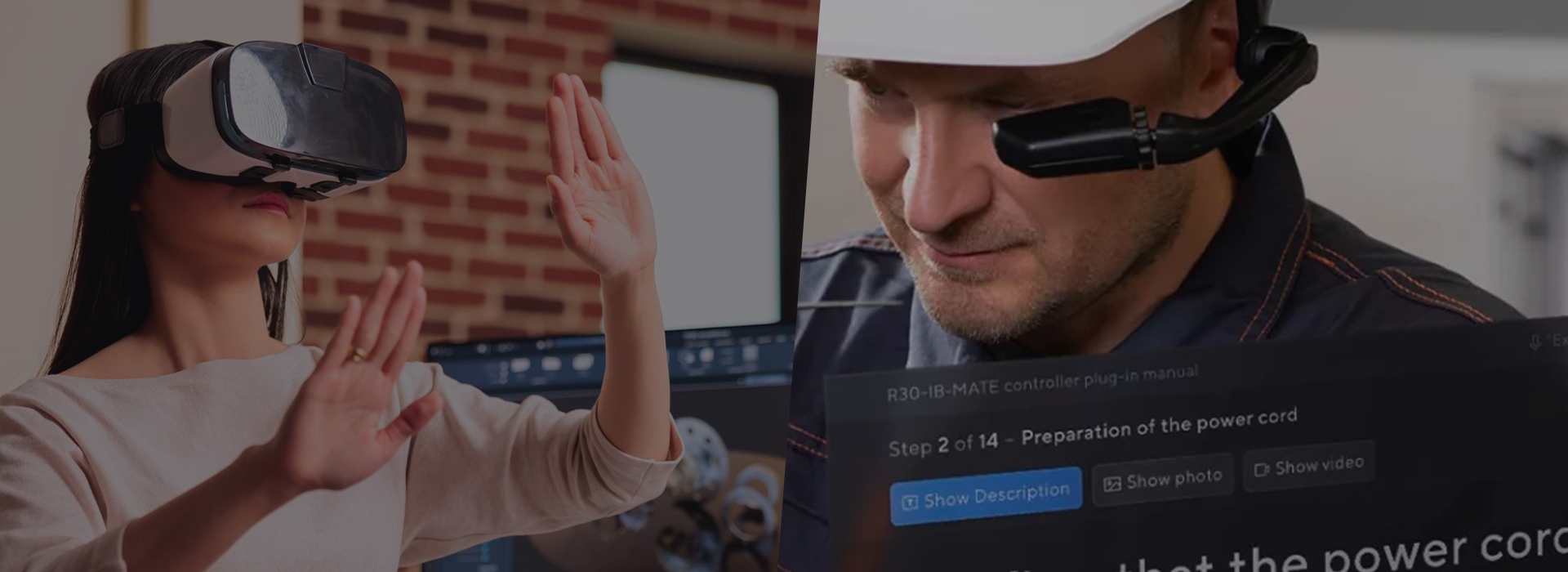Augmented reality, virtual reality. Who is who? And what do they have to offer?
Reaching beyond what’s real – realities other than the actual one and their professional application.
What is virtual reality (VR)?
VR is the simulated experience of a digitally created world, existing independently of the real surroundings. Users equipped with dedicated VR headsets with near-eye displays can explore the artificial realm by visiting distant locations, acquiring new skills, conducting virtual meetings, or simply enjoying new ideas of fun and entertainment.
The idea of virtual reality, albeit associated with state-of-the-art developments, is not that new, as one might think. It emerged shortly after the invention of photography, a relatively simple apparatus using twin mirrors to project a single image was created. Because of the question, the View-Master is nearly 100 years old and remains in production. The XXth century followed the exploration of simulated environments with, among others, cinematic inventions for the multisensory feel of motion pictures. Nevertheless, virtual reality entered the game (pun intended) in the 1980s, along with goggles and gloves for the whole experience. From cinemas and gaming, the fast track led to NASA and scientific use, and the rest is history. The immersive experience is accessible to individuals via widely available VR headsets, and professional applications of the technology continue to grow across industries.
What is augmented reality (AR)?
AR enables immersive experiences by adding digital elements to the real world. Augmented reality, contrary to VR, doesn’t disconnect the user from their surroundings but instead – allows them to see more.
The concept of augmented reality also has its roots in the cinematography of the late 50s. AR research and development got wind in its sails in the 1960s, when Harvard University professor and computer scientist constructed a head-mounted display, known as the “Sword of Damocles”. The device enhanced users’ sensory perception of their surroundings with computer-generated graphics. The term augmented reality was coined by a 90s Boeing researcher. Nowadays, AR is utilized both by commercial users and enterprises, serving various purposes.
What’s the difference between augmented reality (AR) and virtual reality (VR)?

Augmented reality and virtual reality are still considered relatively new technologies, which is interesting, to say the least in the field where inventions can become obsolete in just a few years. For a few decades, AR and VR were essentially the same concepts, and their split occurred before most of us were even born.
Augmented reality vs. virtual reality – the difference between AR and VR is straightforward
AR users experience a real-life setting enhanced with digital elements, while VR is entirely virtual. The surroundings in VR can fully reflect the real world, though the user sees only what is displayed on the screen. AR headsets usually present computer-generated content in part of the user’s field of vision, not impeding their perception of the background. In short, VR replaces reality while AR adds to it, projecting supplementary information atop what can be seen with the naked eye.
From a technical point of view – virtual reality requires dedicated equipment, while you can access AR also with everyday devices (smartphones, tablets).
Examples of AR and VR applications
Augmented reality and virtual reality can already be adopted in a vast majority of industries. Below you’ll find just a small fraction of AR and VR’s practical applications.
Virtual reality
Google Earth VR
The go-to place for every millennial exploring the possibilities of the early 21st century World Wide Web. Thousands of us spent hours loading the website just to see the roof of our house. Now we can do the same, in an immersive way. The browser-based app enables users to visit sites and landmarks using, e.g. the Oculus headset. Aside from just checking attractions prior to going on holidays or visiting childhood playgrounds, Google Earth VR is a great tool for learning geography and familiarizing users with real-world destinations.
Osso VR
A VR surgical training and assessment platform. The app enables doctors to interact with medical devices and perform surgeries on virtual patients. The core benefit is familiarizing medics with new equipment and making it possible to master their operation. With gamification mechanisms and advanced analytics, Osso VR enables measuring progress and engagement, not to mention high success rates of newly introduced devices.
Virtual Speech
A VR app created for efficient and immersive soft skills training. Realistic scenarios simulate real-life situations fostering learning and making behavioral changes. Users can practice various settings, e.g. speaking at a press conference or in a TV studio, thus overcoming their stress and anxiety. Learning by doing leads to engagement boosts and improves retention, while data-driven insights and feedback help identify areas for further improvement.
Disney Movies VR
VR enables experiencing the all-time movie classics, allowing one to step into Disney movies. Additionally, the app invites users to explore world-known amusement locations and other activities, like Coco VR, made particularly for the social VR experience.
Augmented reality
Nsflow
The AR and AI-powered platform is an all-in-one solution for supporting frontline workers. A tool enabling knowledge management, maintenance and service procedures, and even efficient hands-on training, arose from understanding the needs of industrial enterprises. On-site technicians equipped with AR goggles (or everyday devices) can communicate in real-time, while performing their tasks, with experts located anywhere in the world. Acknowledging digital additives in their surroundings, personnel can work hands-free and safely execute various procedures. Read more to see practical examples of AR applications in industrial conditions: predictive maintenance processes, remote inspections, and health and safety training.
Complete Anatomy with AR
High-tech study aid for medical students. Digital models of the human body allow users to learn particular structures, see and understand how their work. What may seem gruesome to onlookers is priceless to healthcare professionals in training – the app enables a virtual simulation of autopsies. A digital figure can be peeled off layers of body shells, presenting the underneath vessels and connective systems. With the AR interactive anatomy models, students can get a glimpse inside physiological structures, learning incomparably more efficiently than from paper-based drawings and diagrams.
IKEA Place
Will the sofa’s color match the curtains? Or, even more importantly, will the new piece fit in your interior? The furniture retail giant is all for useful inventions, and their digital side is up to date with trends. To save their customers’ time and hassle, IKEA developed an application to try out their new home amenities in virtual surroundings. The 98% success rate, doesn’t leave much room for a traditional measuring tape to shine. The Place app is followed by Kreativ, a VR app using LIDAR scanners for even more advanced, 3D home makeovers.
Of course, there are plenty of AR/VR apps made for the sole purpose of entertainment. The most well-known one, bringing the concept of AR to the greater public, is Pokémon Go. The 2016 phenomenon has had millions of users roaming around their neighborhoods, searching for digital creatures. Some even say that the memorable summer when the craze started was the closest we were to world peace in XXI. Jokes aside, it’s been the first broad audience experience of augmented reality. Only a few years later, people got to encounter it in numerous other fields of daily life.
Another lighthearted example of AR in everyday life is Snapchat, the multimedia instant messaging app. Snapchat Lenses provide the AR experience, allowing users to transform the way they look, and their surroundings. With the help of Lenses, Snapchatters can change their image and incorporate 3D effects, objects, and characters.
What’s best for business?
AR vs. VR – who wins the battle for professional users’ hearts? There’s – as usual – no short answer. The difference between virtual reality and the actual realm is what provides for their business applications. Thanks to combining elements from both worlds, the real and digital, AR suits cases where users need to assess their surroundings. VR, on the other hand, can be used in cases requiring full immersion, cutting the user off from external distractions.
Both AR and VR technologies can be applied in the same fields but contribute different values. For example, while AR enables healthcare providers to look simultaneously at the patient and their digitally presented vitals, VR supports patient rehabilitation from various conditions and disorders. The beneficial effect is still under review and research, though what we know for certain is that the new tools offer hope for new solutions to old problems, including PTSD and dementia. Similarly, in the automotive industry, both technologies are used in, e.g. design and prototyping, shortening the manufacturing processes with fewer physical models needed to deliver the final product.
While we refrain from pointing to an undeniable winner in the VR vs. AR duel, we do have some arguments for augmented reality.

presentation to try
Nsflow in action
The future of AR and VR
Today’s world proves that digital technology enhances various aspects of life at every step. The COVID-19 pandemic contributed to the growth of new solutions, especially those enabling remote work. With several challenges already identified and requiring immediate action, AR and VR appear invaluable allies.
One of the challenges is access to education and specialists, not only due to travel bans and health restrictions. For example, the medical field suffers from the lack of qualified personnel – in less populated areas and larger cities alike, due to generational change, long-lasting training, and low wages. As a result, professionals are often in greater demand than the available supply. Access to remote experts operating AR could significantly aid medics in providing health services, which would be impossible with the use of traditional means. The example given is just one of the numerous real-life cases where the demand for augmented reality is no longer science fiction but a genuine answer to identified problems.
Augmented reality and virtual reality are on the rise, and we’re yet to see their full business potential. Do you want to try out AR in your operations? Let us know – we’re happy to answer any questions you may have.


























